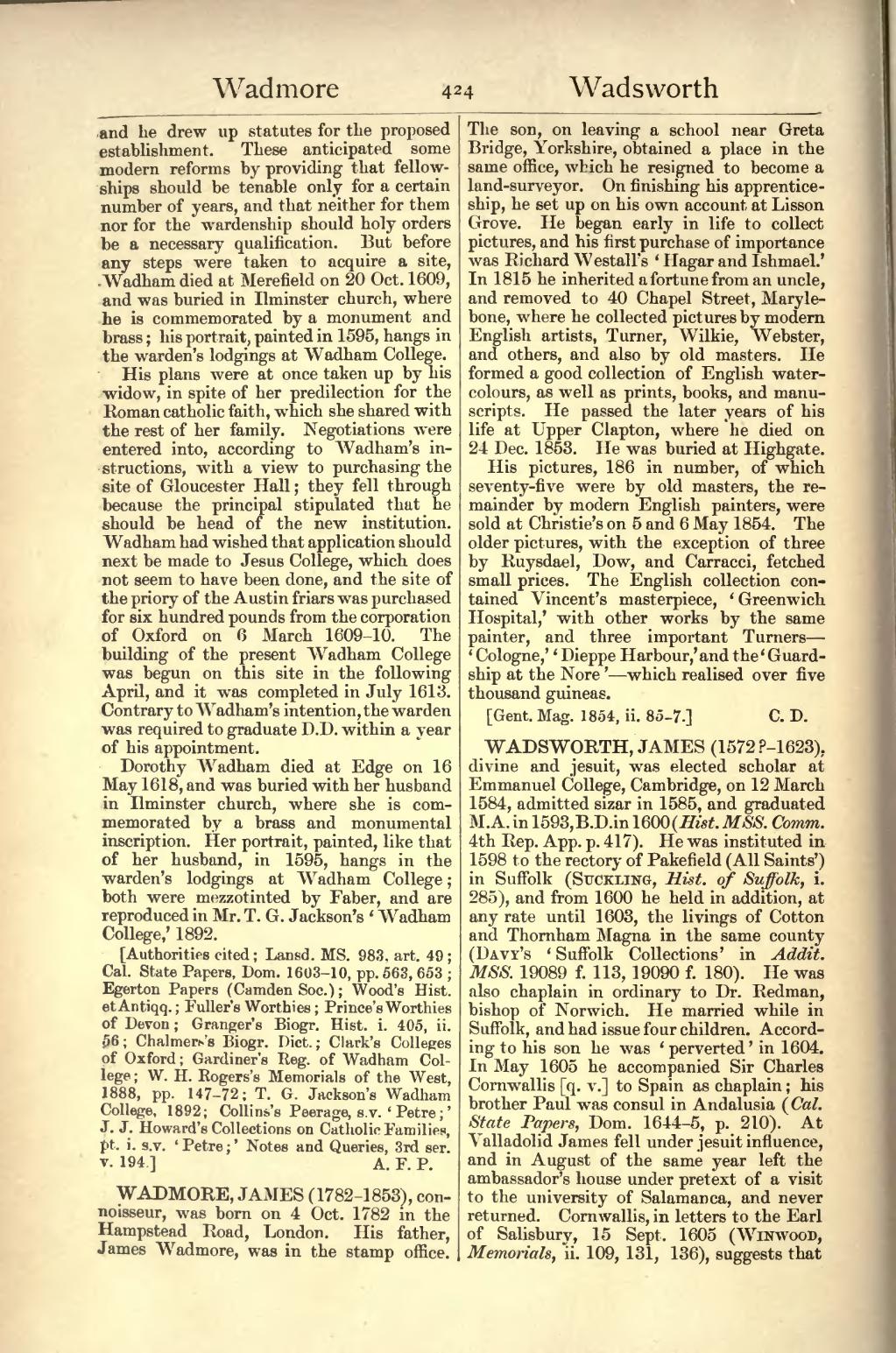and he drew up statutes for the proposed establishment. These anticipated some modern reforms by providing that fellowships should be tenable only for a certain number of years, and that neither for them nor for the wardenship should holy orders be a necessary qualification. But before any steps were taken to acquire a site, Wadham died at Merefield on 20 Oct. 1609, and was buried in Ilminster church, where he is commemorated by a monument and brass; his portrait, painted in 1595, hangs in the warden's lodgings at Wadham College.
His plans were at once taken up by his widow, in spite of her predilection for the Roman catholic faith, which she shared with the rest of her family. Negotiations were entered into, according to Wadham's instructions, with a view to purchasing the site of Gloucester Hall; they fell through because the principal stipulated that he should be head of the new institution. Wadham had wished that application should next be made to Jesus College, which does not seem to have been done, and the site of the priory of the Austin friars was purchased for six hundred pounds from the corporation of Oxford on 6 March 1609–10. The building of the present Wadham College was begun on this site in the following April, and it was completed in July 1613. Contrary to Wadham's intention, the warden was required to graduate D.D. within a year of his appointment.
Dorothy Wadham died at Edge on 16 May 1618, and was buried with her husband in Ilminster church, where she is commemorated by a brass and monumental inscription. Her portrait, painted, like that of her husband, in 1595, hangs in the warden's lodgings at Wadham College; both were mezzotinted by Faber, and are reproduced in Mr. T. G. Jackson's ‘Wadham College,’ 1892.
[Authorities cited; Lansd. MS. 983, art. 49; Cal. State Papers, Dom. 1603–10, pp. 563, 653; Egerton Papers (Camden Soc.); Wood's Hist. et Antiqq.; Fuller's Worthies; Prince's Worthies of Devon; Granger's Biogr. Hist. i. 405, ii. 56; Chalmers's Biogr. Dict.; Clark's Colleges of Oxford; Gardiner's Reg. of Wadham College; W. H. Rogers's Memorials of the West, 1888, pp. 147–72; T. G. Jackson's Wadham College, 1892; Collins's Peerage, s.v. ‘Petre;’ J. J. Howard's Collections on Catholic Families, pt. i. s.v. ‘Petre;’ Notes and Queries, 3rd ser. v. 194.]
WADMORE, JAMES (1782–1853), connoisseur, was born on 4 Oct. 1782 in the Hampstead Road, London. His father, James Wadmore, was in the stamp office. The son, on leaving a school near Greta Bridge, Yorkshire, obtained a place in the same office, which he resigned to become a land-surveyor. On finishing his apprenticeship, he set up on his own account at Lisson Grove. He began early in life to collect pictures, and his first purchase of importance was Richard Westall's ‘Hagar and Ishmael.’ In 1815 he inherited a fortune from an uncle, and removed to 40 Chapel Street, Marylebone, where he collected pictures by modern English artists, Turner, Wilkie, Webster, and others, and also by old masters. He formed a good collection of English watercolours, as well as prints, books, and manuscripts. He passed the later years of his life at Upper Clapton, where he died on 24 Dec. 1853. He was buried at Highgate. His pictures, 186 in number, of which seventy-five were by old masters, the remainder by modern English painters, were sold at Christie's on 5 and 6 May 1854. The older pictures, with the exception of three by Ruysdael, Dow, and Carracci, fetched small prices. The English collection contained Vincent's masterpiece, ‘Greenwich Hospital,’ with other works by the same painter, and three important Turners—‘Cologne,’ ‘Dieppe Harbour,’ and the ‘Guardship at the Nore’—which realised over five thousand guineas.
[Gent. Mag. 1854, ii. 85–7.]
WADSWORTH, JAMES (1572?–1623), divine and jesuit, was elected scholar at Emmanuel College, Cambridge, on 12 March 1584, admitted sizar in 1585, and graduated M.A. in 1593, B.D. in 1600 (Hist. MSS. Comm. 4th Rep. App. p. 417). He was instituted in 1598 to the rectory of Pakefield (All Saints') in Suffolk (Suckling, Hist. of Suffolk, i. 285), and from 1600 he held in addition, at any rate until 1603, the livings of Cotton and Thornham Magna in the same county (Davy's ‘Suffolk Collections’ in Addit. MSS. 19089 f. 113, 19090 f. 180). He was also chaplain in ordinary to Dr. Redman, bishop of Norwich. He married while in Suffolk, and had issue four children. According to his son he was ‘perverted’ in 1604. In May 1605 he accompanied Sir Charles Cornwallis [q. v.] to Spain as chaplain; his brother Paul was consul in Andalusia (Cal. State Papers, Dom. 1644–5, p. 210). At Valladolid James fell under jesuit influence, and in August of the same year left the ambassador's house under pretext of a visit to the university of Salamanca, and never returned. Cornwallis, in letters to the Earl of Salisbury, 15 Sept. 1605 (Winwood, Memorials, ii. 109, 131, 136), suggests that
